Tourists and Local Stakeholders’ Perception of Ecosystem Services Provided by Summer Farms in the Eastern Italian Alps
Abstract
1. Introduction
2. Materials and Methods
2.1. Study Area
2.1.1. Online Questionnaire with the Local Stakeholders
2.1.2. Focus Groups with the Local Stakeholders
2.1.3. Self-Filled Questionnaires with the Tourists
2.1.4. Comparison between the Perceptions of the Local Stakeholders and Tourists
3. Results
3.1. Questionnaires with Local Stakeholders and Tourists
3.1.1. Perceptions of Summer Farms
3.1.2. Perception of ESs Provided by Alpine Pastures
3.2. Focus Groups with the Local Stakeholders
4. Discussion
5. Conclusions
Author Contributions
Funding
Acknowledgments
Conflicts of Interest
References
- Battaglini, L.; Bovolenta, S.; Gusmeroli, F.; Salvador, S.; Sturaro, E. Environmental Sustainability of Alpine Livestock Farms. Ital. J. Anim. Sci. 2014. [Google Scholar] [CrossRef]
- Bernués, A.; Ruiz, R.; Olaizola, A.; Villalba, D.; Casasús, I. Sustainability of pasture-based livestock farming systems in the European Mediterranean context: Synergies and trade-offs. Livest. Sci. 2011, 139, 44–57. [Google Scholar] [CrossRef]
- EEA. Europe’s Ecological Backbone: Recognising the True Value of Our Mountains; European Environment Agency Publications: Copenhagen, Denmark, 2010. [Google Scholar]
- Rodríguez-Ortega, T.; Oteros-Rozas, E.; Ripoll-Bosh, R.; Tichit, M. Applying the ecosystem services framework to pasture-based livestock farming systems in Europe. Animal 2014, 8, 1361–1372. [Google Scholar] [CrossRef] [PubMed]
- Schirpke, U.; Leitinger, G.; Tasser, E.; Schermer, M.; Steinbacher, M.; Tappeiner, U. Multiple ecosystem services of a changing Alpine landscape: Past, present and future. Int. J. Biodivers. Sci. Ecosyst. Serv. Manag. 2013, 9, 123–135. [Google Scholar] [CrossRef]
- MEA. Ecosystems and Human Well-Being; Island Press: Washington, DC, USA, 2005. [Google Scholar]
- TEEB. The Economics of Ecosystem Services and Biodiversity; Earthscan: London, UK, 2010. [Google Scholar]
- Sturaro, E.; Thiene, M.; Cocca, G.; Mrad, M.; Tempesta, T.; Ramanzin, M. Factors influencing summer farms management in the Alps. Ital. J. Anim. Sci. 2013, 12, e25. [Google Scholar] [CrossRef]
- Burrascano, S.; Chytry, M.; Kuemmerle, T.; Giarrizzo, E.; Luyssaert, S.; Sabatini, F.M.; Blasi, C. Current European policies are unlikely to jointly foster carbon sequestration and protect biodiversity. Biol. Conserv. 2016, 201, 370–376. [Google Scholar] [CrossRef]
- Tasser, E.; Walde, J.; Tappeiner, U.; Teutsch, A.; Noggler, W. Land-use changes and natural reforestation in the Eastern Central Alps. Agric. Ecosyst. Environ. 2007, 118, 115–129. [Google Scholar] [CrossRef]
- Silva, V.; Catry, F.X.; Fernandes, P.M.; Rego, F.C.; Paes, P.; Nunes, L.; Caperta, A.D.; Sérgio, C.; Bugalho, M.N. Effects of grazing on plant composition, conservation status and ecosystem services of Natura 2000 shrub-grassland habitat types. Biodivers. Conserv. 2019, 28, 1205–1224. [Google Scholar] [CrossRef]
- Laiolo, P.; Dondero, F.; Ciliento, E.; Rolando, A. Consequences of pastoral abandonment for the structure and diversity of the alpine avifauna. J. Appl. Ecol. 2004, 41, 294–304. [Google Scholar] [CrossRef]
- Macagno, A.L.M.; Palestrini, C. The maintenance of extensively exploited pastures within the Alpine mountain belt: Implications for dung beetle conservation (Coleoptera: Scarabaeoidea). Biodivers. Conserv. 2009, 18, 3309. [Google Scholar] [CrossRef]
- Niedrist, G.; Tasser, E.; Lüth, C.; Dalla Via, J.; Tappeiner, U. Plant diversity declines with recent land use changes in European Alps. Plant Ecol. 2009, 202, 195. [Google Scholar] [CrossRef]
- Schirpke, U.; Altzinger, A.; Leitinger, G.; Tasser, E. Change from agricultural to touristic use: Effects on the aesthetic value of landscapes over the last 150 years. Landsc. Urban Plan. 2019, 187, 23–35. [Google Scholar] [CrossRef]
- Scolozzi, R.; Schirpke, U.; Detassis, C.; Abdullah, S.; Gretter, A. Mapping Alpine Landscape Values and Related Threats as Perceived by Tourists. Landsc. Res. 2015, 40, 451–465. [Google Scholar] [CrossRef]
- Von Glasenapp, M.; Thornton, T.F. Traditional Ecological Knowledge of Swiss Alpine Farmers and their Resilience to Socioecological Change. Hum. Ecol. 2011, 39, 769–781. [Google Scholar] [CrossRef]
- Kianicka, S.; Knab, L.; Buchecker, M. Maiensäss—Swiss Alpine summer farms—An element of cultural heritage between conservation and further development: A qualitative case study. Int. J. Herit. Stud. 2010, 16, 486–507. [Google Scholar] [CrossRef]
- Cocca, G.; Sturaro, E.; Gallo, L.; Ramanzin, M. Is the abandonment of traditional livestock farming systems the main driver of mountain landscape change in Alpine areas? Land Use Policy 2012, 29, 878–886. [Google Scholar] [CrossRef]
- EEA. 10 Messages for 2010. Mountain Ecosystems; European Environment Agency Publications: Copenhagen, Denmark, 2010. [Google Scholar]
- Strijker, D. Marginal lands in Europe: Causes of decline. Basic Appl. Ecol. 2005, 6, 99–106. [Google Scholar] [CrossRef]
- Tasser, E.; Mader, M.; Tappeiner, U. Effects of land use in alpine grasslands on the probability of landslides. Basic Appl. Ecol. 2003, 4, 271–280. [Google Scholar] [CrossRef]
- Johansen, L.; Taugourdeau, S.; Hovstad, K.A.; Wehn, S. Ceased grazing management changes the ecosystem services of semi-natural grasslands. Ecosyst. People 2019, 15, 192–203. [Google Scholar] [CrossRef]
- Schirpke, U.; Kohler, M.; Leitinger, G.; Fontana, V.; Tasser, E.; Tappeiner, U. Future impacts of changing land-use and climate on ecosystem services of mountain grassland and their resilience. Ecosyst. Serv. 2007, 26, 79–94. [Google Scholar] [CrossRef]
- Vigl, E.; Schirpke, U.; Tasser, E.; Taippener, U. Linking long-term landscape dynamics to the multiple interactions among ecosystem services in the European Alps. Landsc. Ecol. 2016, 31, 1903–1918. [Google Scholar] [CrossRef]
- Faccioni, G.; Bernués, A.; Ramanzin, M.; Sturaro, E. Social valuation of ecosystem services provided by livestock farming in the Italian Alps. Grassl. Sci. Eur. 2017, 22, 314–316. [Google Scholar]
- Bernués, A.; Rodrıguez-Ortega, T.; Ripoll-Bosch, R.; Alfnes, F. Socio-Cultural and Economic Valuation of Ecosystem Services Provided by Mediterranean Mountain Agroecosystems. PLoS ONE 2014, 9, e102479. [Google Scholar] [CrossRef]
- Mengist, W.; Soromessa, T.; Legese, G. Ecosystem services research in mountainous regions: A systematic literature review on current knowledge and research gaps. Sci. Total Environ. 2020, 702, 134581. [Google Scholar] [CrossRef]
- Martín-López, B.; Leister, I.; Lorenzo Cruz, P.; Palomo, I.; Grêt-Regamey, A.; Harrison, P.A.; Lavorel, S.; Locatelli, B.; Luque, S.; Walz, A. Nature’s contributions to people in mountains: A review. PLoS ONE 2019, 14, e0217847. [Google Scholar] [CrossRef]
- Bernués, A.; Frode, A.; Morten, C.; Lars, O.; Faccioni, G.; Ramanzin, M.; Ripoll-Bosch, R.; Rodríguez-Ortega, T.; Sturaro, E. Exploring social preferences for ecosystem services of multifunctional agriculture across policy scenarios. Ecosyst. Serv. 2019, 39, 101002. [Google Scholar] [CrossRef]
- Faccioni, G.; Sturaro, E.; Ramanzin, M.; Bernués, A. Socio-economic valuation of abandonment and intensification of Alpine agroecosystems and associated ecosystem services. Land Use Policy 2019, 81, 453–462. [Google Scholar] [CrossRef]
- Province of Trento. Operazione 10.1.2—Gestione delle superfici a pascolo: Aiuti a favore dell’alpeggio. Available online: http://www.psr.provincia.tn.it/Sviluppo-Rurale-2014-2020/Misure/M10-Pagamenti-agroambientali/Sottomisura-10.12 (accessed on 14 January 2020).
- Schirpke, U.; Hölzler, S.; Leitinger, G.; Bacher, M.; Tappeiner, U.; Tasser, E. Can we model the scenic beauty of an alpine landscape? Sustainability 2013, 5, 1080–1094. [Google Scholar] [CrossRef]
- ISTAT. Istituto Nazionale di Statistica. VI Censimento generale dell’Agricoltura. 2010. Available online: http://censimentoagricoltura.istat.it/ (accessed on 10 September 2019).
- FBTP. Federation of Breeders of the Trento Province, General Assembly 2018; Internal report; FBTP: Trento, Italy, 2018. [Google Scholar]
- Concast. Bilancio 2018; Concast: Trento, Italy, 2019. [Google Scholar]
- Zendri, F.; Sturaro, E.; Ramanzin, M. Highland Summer Pastures Play a Fundamental Role for Dairy Systems in an Italian Alpine Region. Agric. Conspec. Sci. 2013, 78, 295–299. [Google Scholar]
- Province of Trento. Trentino Agricoltura. Malghe. Available online: http://www.trentinoagricoltura.it/Trentino-Agricoltura/Settori2/Malghe (accessed on 22 July 2019).
- Sturaro, E.; Marchiori, E.; Cocca, G.; Penasa, M.; Ramanzin, M.; Bittante, G. Dairy systems in mountainous areas: Farm animal biodiversity, milk production and destination, and land use. Livest. Sci. 2013, 158, 157–168. [Google Scholar] [CrossRef]
- Evans, K.; Velarde, S.J.; Prieto, R.P.; Rao, S.N.; Sertzen, S.; Davila, K.; Cronkleton, P.; de Jong, W. Field Guide to the Future: Four Ways for Communities to Think Ahead; CIFOR: Nairobi, Kenya, 2006. [Google Scholar]
- Wright, K.B. Researching Internet-based populations: Advantages and disadvantages of online survey research, online questionnaire authoring software packages, and web survey services. J. Comput.-Mediat. Commun. 2005, 10. [Google Scholar] [CrossRef]
- FAO. Ecosystem Services and Biodiversity. Available online: http://www.fao.org/policy-support/policy-themes/ecosystem-services-biodiversity/en/ (accessed on 15 October 2019).
- Elliott, J.; Heesterbeek, S.; Lukensmeyer, C.J.; Slocum, N. Participatory Methods Toolkit: A Practitioner’s Manual; King Baudouin Foundation and the Flemish Institute for Science and Technology Assessment (viWTA): Brussels, Belgium, 2005. [Google Scholar]
- Stewart, D.W.; Shamdasani, P.N. Focus Groups: Theory and Practice, 3rd ed.; SAGE Publications, Inc.: Thousand Oaks, CA, USA, 2014; pp. 39–139. [Google Scholar]
- Sidali, K.L.; Huber, D.; Schamel, G. Long-Term Sustainable Development of Tourism in South Tyrol: An Analysis of Tourists’ Perception. Sustainability 2017, 9, 1791. [Google Scholar] [CrossRef]
- Schmidt, K.; Walz, A.; Martin-Lopez, B.; Sachse, R. Testing socio-cultural valuation methods of ecosystem services to explain land use preferences. Ecosyst. Servs. 2017, 26, 270–288. [Google Scholar] [CrossRef]
- Pachoud, C. Identity, feeling of belonging and collective action in localized agrifood systems. Example of the Serrano cheese in the Campos de Cima da Serra, Brazil. Cah. Agric. 2019. [Google Scholar] [CrossRef]
- Zuliani, A.; Esbjerg, L.; Grunert, K.G.; Bovolenta, S. Animal Welfare and Mountain Products from Traditional Dairy Farms: How Do Consumers Perceive Complexity? Animals 2018, 8, 207. [Google Scholar] [CrossRef]
- Lamarque, P.; Tappeiner, U.; Turner, C.; Steinbacher, M.; Bardgett, R.D.; Szukics, U.; Schermer, M.; Lavorel, S. Stakeholder perceptions of grassland ecosystem services in relation to knowledge on soil fertility and biodiversity. Reg. Environ. Chang. 2011, 11, 791–804. [Google Scholar] [CrossRef]
- Zoderer, M.B.; Tasser, E.; Erb, K.H.; Lupo Stanghellini, P.S.; Tappeiner, U. Identifying and mapping the tourists: Perception of cultural ecosystem services: A case study from an Alpine region. Land Use Policy 2016, 56, 251–261. [Google Scholar] [CrossRef]
- Bernués, A.; Rodríguez-Ortega, T.; Ripoll-Bosch, R.; Casasús, I. A qualitative research on Spanish farmers and citizens perceptions of ecosystem services provided by mountain livestock farming. In Proceedings of the 17th Meeting of the FAO-CIHEAM Mountain Pasture Network—Pastoralism and Ecosystem Conservation, Trivero, Italy, 5–7 June 2013. [Google Scholar]
- Martínez-Harms, M.J.; Balvanera, P. Methods for mapping ecosystem service supply: A review. Int. J. Biodivers. Sci. Ecosyst. Serv. Manag. 2012, 8, 1–2. [Google Scholar] [CrossRef]
- Bernués, A. Animals on the Land. Ecosystem services and disservices of grazing livestock systems. In The Meat Crisis. Developing more Sustainable and Ethical Production and Consumption; D’Silva, J., Webster, J., Eds.; Routledge: London, UK, 2017; pp. 63–89. [Google Scholar]
- Schirpke, U.; Timmermann, F.; Tappeiner, U.; Tasser, U. Cultural ecosystem services of mountain regions: Modelling the aesthetic value. Ecol. Indic. 2016, 69, 78–90. [Google Scholar] [CrossRef]
- Rüdisser, J.; Schirpke, U.; Tappeinera, U. Symbolic entities in the European Alps: Perception and use of a cultural ecosystem service. Ecosyst. Serv. 2019, 39, 100980. [Google Scholar] [CrossRef]
- Tinch, R.; Beaumont, N.; Sunderland, T.; Ozdemiroglu, E.; Barton, D.; Bowe, C.; Börger, T.; Burgess, P.; Cooper, C.N.; Faccioli, M.; et al. Economic valuation of ecosystem goods and services: A review for decision makers. J. Environ. Econ. Policy 2019, 92, 1–20. [Google Scholar] [CrossRef]
- Rodríguez-Ortega, T.; Bernués, A.; Alfnes, F. Psychographic profile affects willingness to pay for ecosystem services provided by Mediterranean high nature value farmland. Ecol. Econ. 2016, 128, 232–245. [Google Scholar] [CrossRef]
- De Meo, I.; Cantiani, M.G.; Ferretti, F.; Paletto, A. Qualitative Assessment of Forest Ecosystem Services: The Stakeholders’ Point of View in Support of Landscape Planning. Forests 2018, 9, 465. [Google Scholar] [CrossRef]
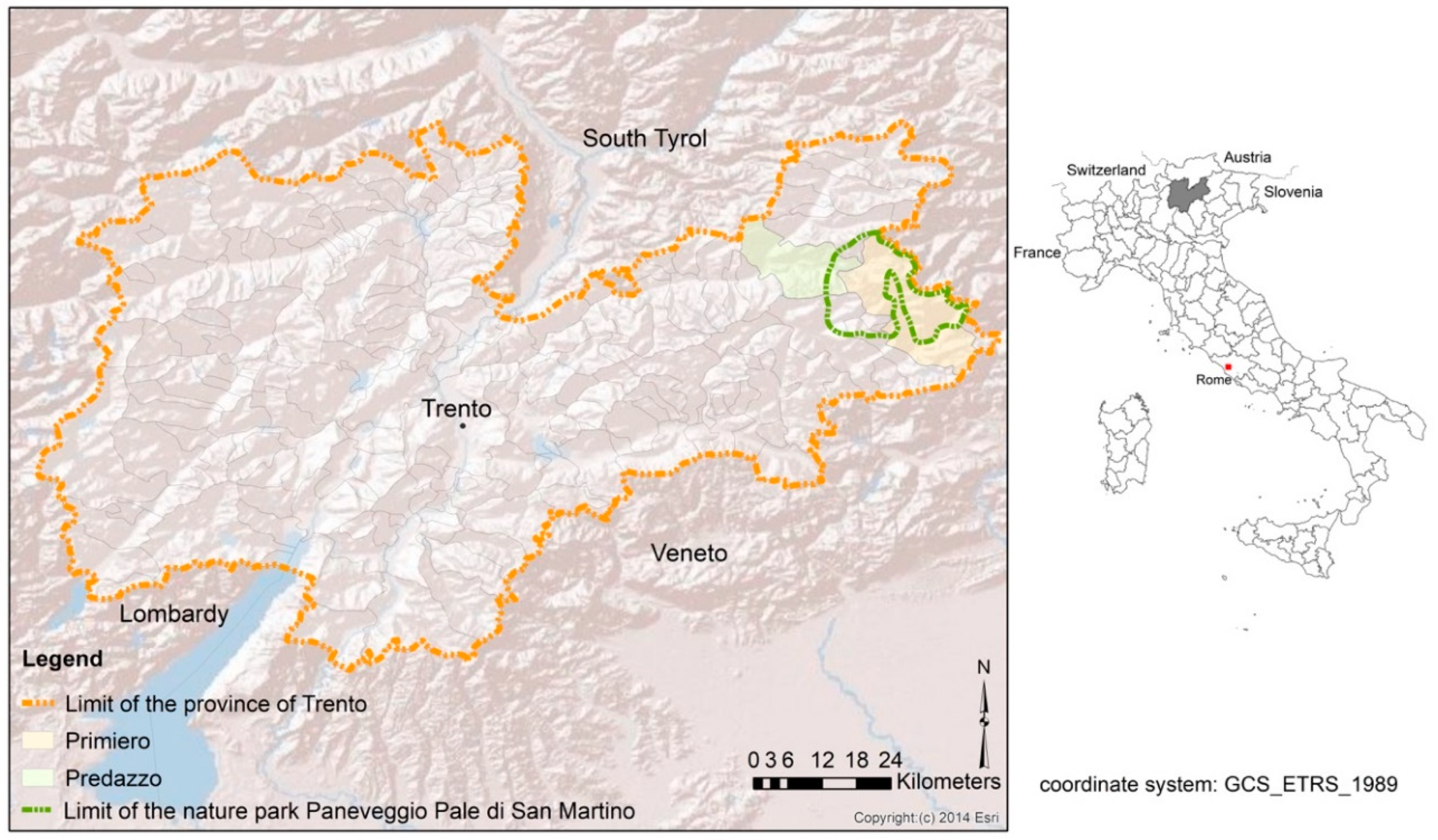
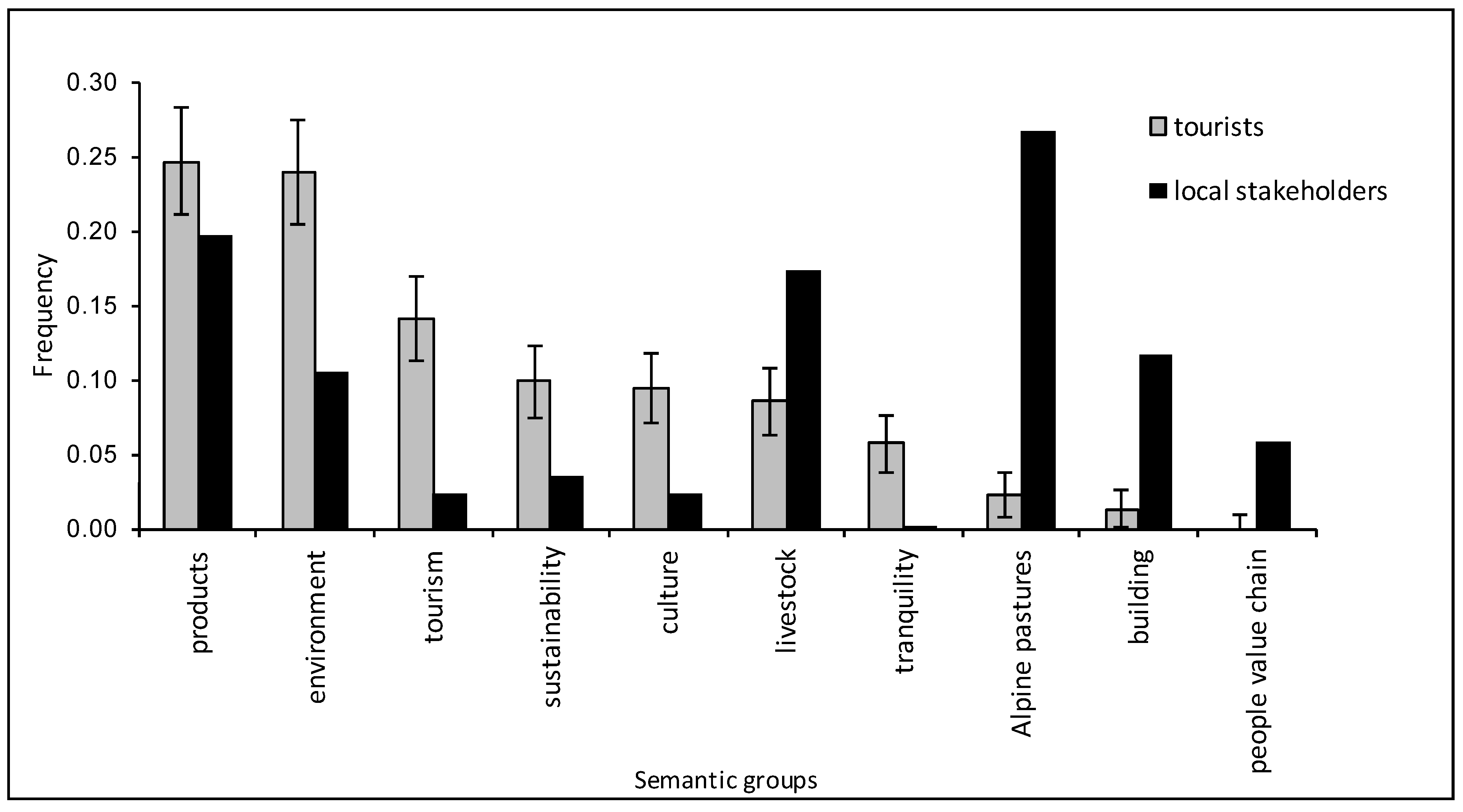
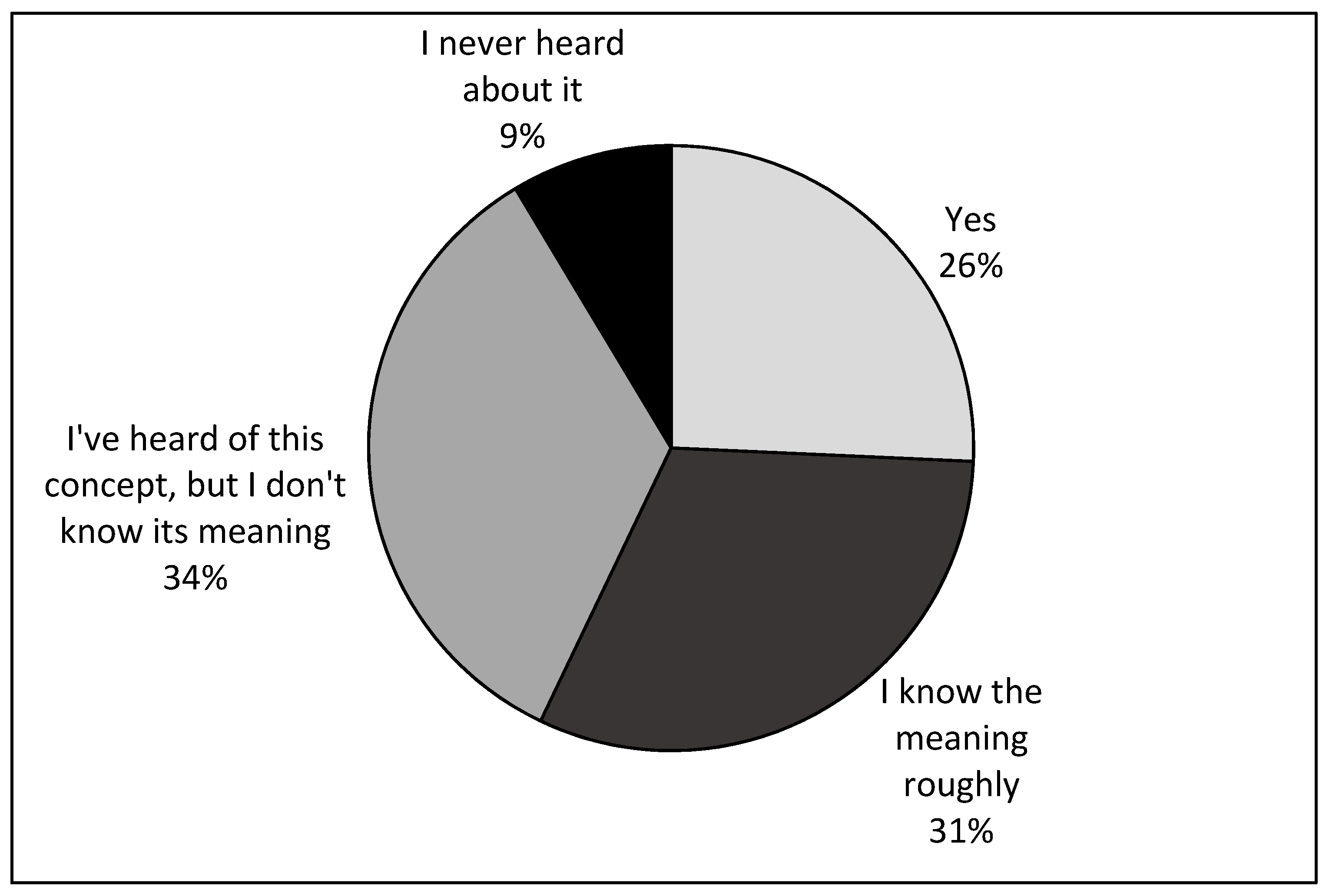
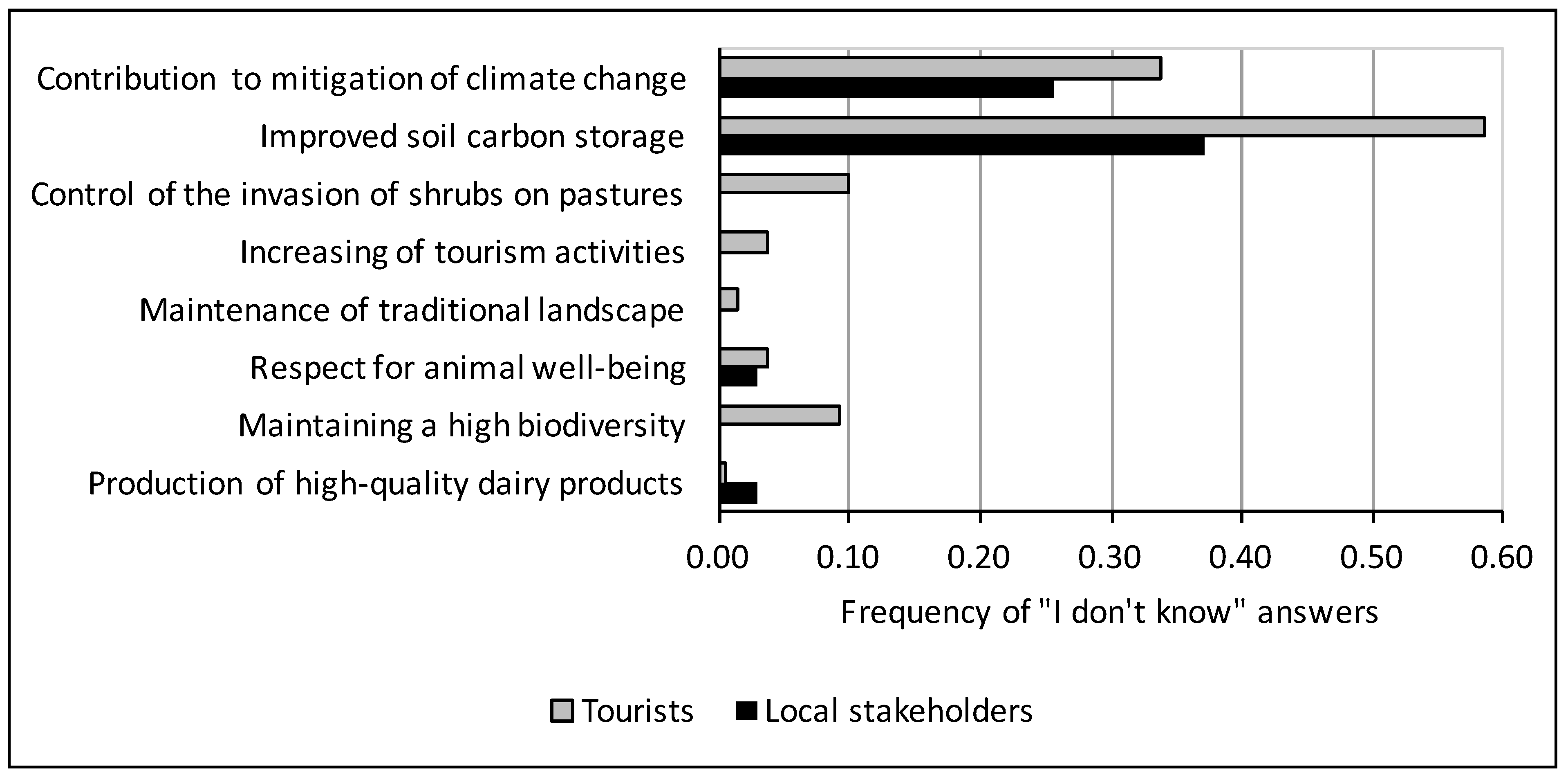
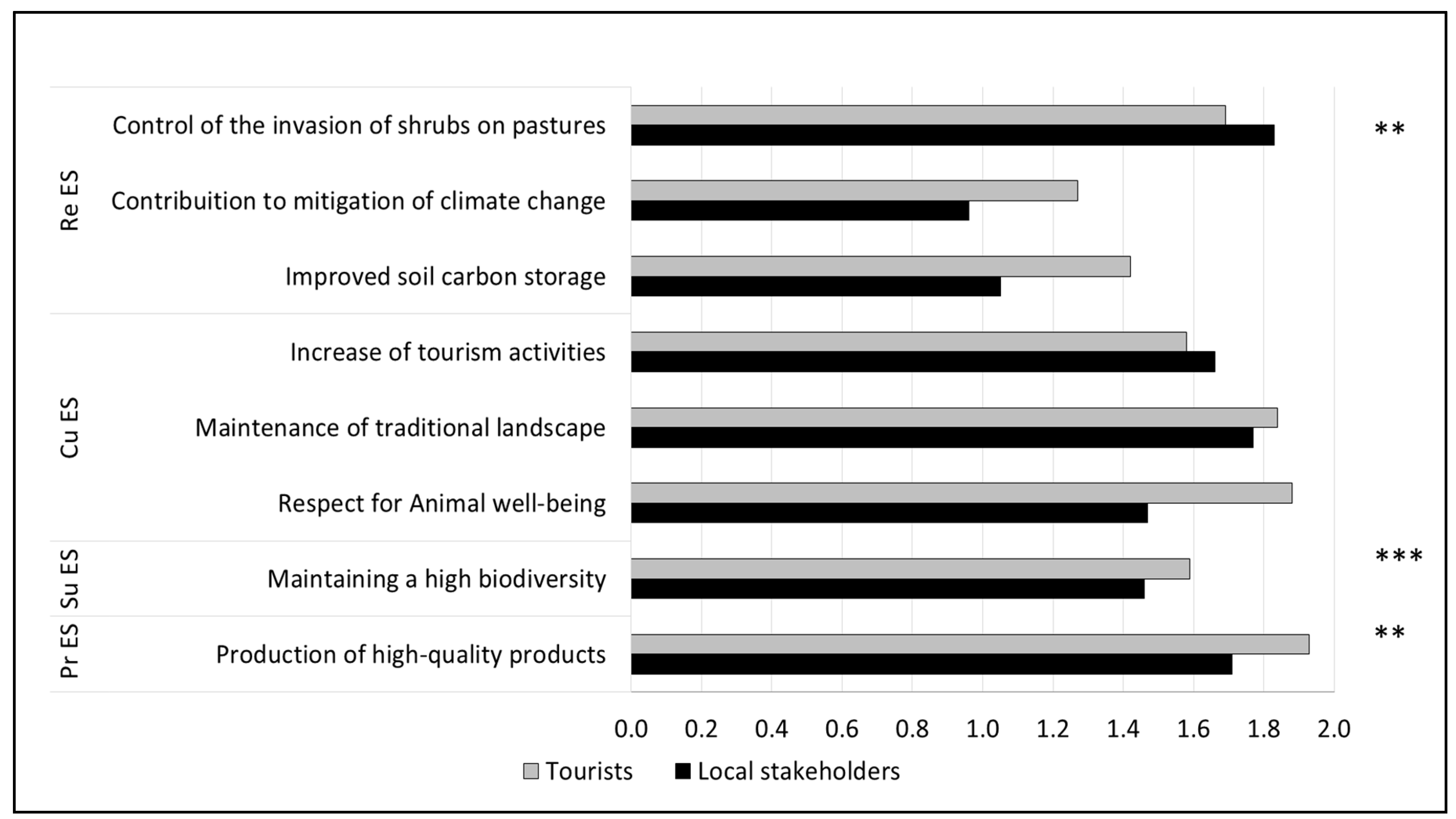
| ESs Type | Specific ESs |
|---|---|
| Provisioning ESs |
|
| Supporting ESs |
|
| Cultural ESs |
|
| Regulating ESs |
|
| Questionnaire | Focus Groups | ||
|---|---|---|---|
| Stakeholders | Number of Respondents | Primiero | Predazzo |
| Farmers | 4 | 1 | 0 |
| Summer farm managers | 2 | 2 | 0 |
| Dairy cooperative representatives | 3 | 1 | 1 |
| Local authority representatives 1 | 5 | 3 | 5 |
| Tourism operators | 13 | 2 | 4 |
| Cultural operators | 7 | 2 | 1 |
| Others 2 | 1 | 0 | 0 |
| Total | 35 | 11 | 11 |
| Session | Comments | Leading Questions |
|---|---|---|
| Session 1: Important Ecosystem Services (ESs) provided by alpine pastures (30 min) | Discussion using post-it: Each participant received 3 post-it cards; the participants noted short statements and presented their comments; the facilitators grouped the cards by resemblance on a flip chart. | What are according to you the main ESs provided by the Alpine pastures, that could be used to improve communication on summer farm products? |
| Session 2: Assessment of ESs (30 min) | Online survey results of the assessment were presented on a poster. The group was requested to provide a new ranking if wanted. | Do you agree with the current ranking? If not, please provide a new ranking. |
| Semantic Groups | Most Frequent Induced Words | |
|---|---|---|
| Local Stakeholders | Tourists | |
| Alpine pastures | Alpine pastures | Alpine pastures |
| Products | Products, cheese, production, milk | Dairy product, local products, quality products, km0 products, good food, milk, typical products, cheese, salami, typical dishes, production |
| Livestock | Livestock, animals, herd, husbandry, cows | Animals, livestock, husbandry, cows, grazing animals |
| Building | Building, structure, barn | Typical house, building, structure, barn |
| Environment | Nature, territory, environment, altitude | Nature, altitude, landscape, scenery, non-polluted environment, mountain, pure air, green, Dolomites |
| People involved in the value chain | Farmers, shepherds | |
| Sustainability | Management of the territory, care of the territory | Maintenance, preservation, ecosystem protection, services, useful, eco-sustainability, self-sufficiency, small-scale farming, natural production, offer of jobs, respect of the environment, maintenance of human life in the mountains |
| Culture | Culture, tradition | Tradition, way of life, simple life, culture, valorization of the traditions, history, memory, folklore |
| Tourism | Gastronomy, restaurant | Hosting, hospitality, for children, restaurant, clean, meeting point, hiking, reference point, comfortable, fountain, availability |
| Authenticity | Authenticity | Authenticity |
| Animal welfare | Animal welfare | Animal welfare, happy animals |
| Family | Family activity | Family activity |
| Collective property | Collective property | |
| Tranquility | Peace, relax, tranquility, silence, well-being, safety | |
| Primiero | Predazzo |
|---|---|
|
|
© 2020 by the authors. Licensee MDPI, Basel, Switzerland. This article is an open access article distributed under the terms and conditions of the Creative Commons Attribution (CC BY) license (http://creativecommons.org/licenses/by/4.0/).
Share and Cite
Pachoud, C.; Da Re, R.; Ramanzin, M.; Bovolenta, S.; Gianelle, D.; Sturaro, E. Tourists and Local Stakeholders’ Perception of Ecosystem Services Provided by Summer Farms in the Eastern Italian Alps. Sustainability 2020, 12, 1095. https://doi.org/10.3390/su12031095
Pachoud C, Da Re R, Ramanzin M, Bovolenta S, Gianelle D, Sturaro E. Tourists and Local Stakeholders’ Perception of Ecosystem Services Provided by Summer Farms in the Eastern Italian Alps. Sustainability. 2020; 12(3):1095. https://doi.org/10.3390/su12031095
Chicago/Turabian StylePachoud, Carine, Riccardo Da Re, Maurizio Ramanzin, Stefano Bovolenta, Damiano Gianelle, and Enrico Sturaro. 2020. "Tourists and Local Stakeholders’ Perception of Ecosystem Services Provided by Summer Farms in the Eastern Italian Alps" Sustainability 12, no. 3: 1095. https://doi.org/10.3390/su12031095
APA StylePachoud, C., Da Re, R., Ramanzin, M., Bovolenta, S., Gianelle, D., & Sturaro, E. (2020). Tourists and Local Stakeholders’ Perception of Ecosystem Services Provided by Summer Farms in the Eastern Italian Alps. Sustainability, 12(3), 1095. https://doi.org/10.3390/su12031095






